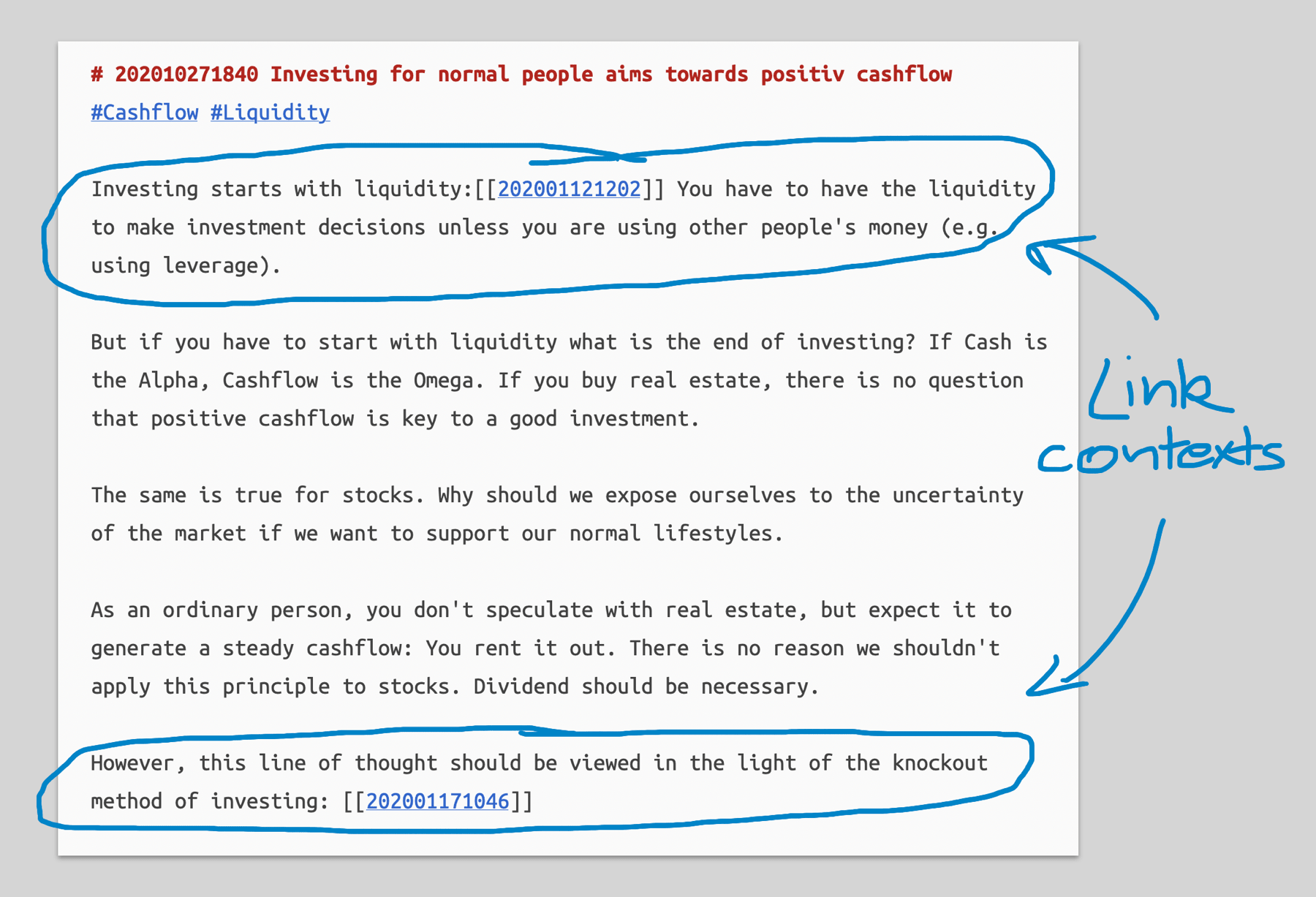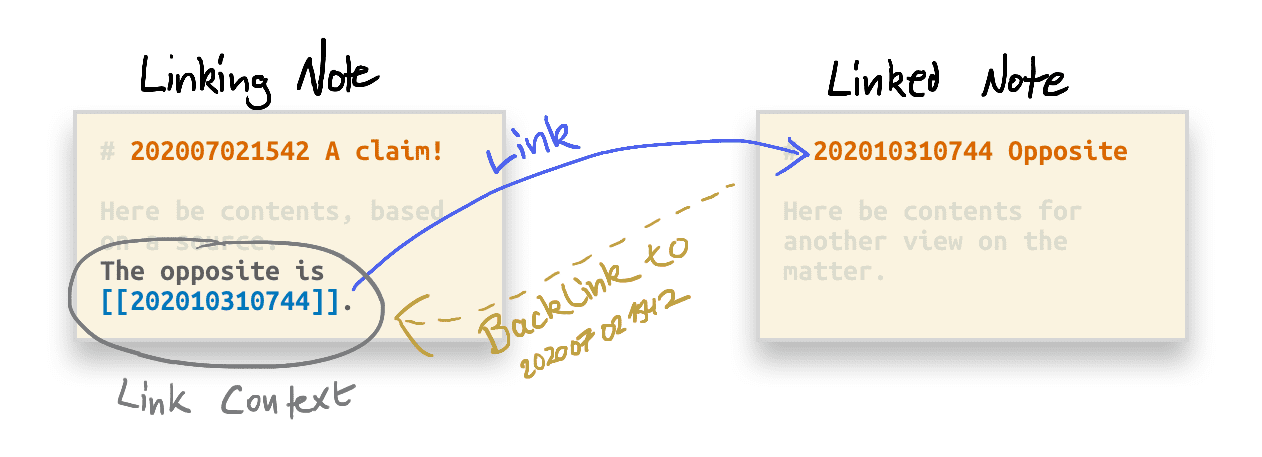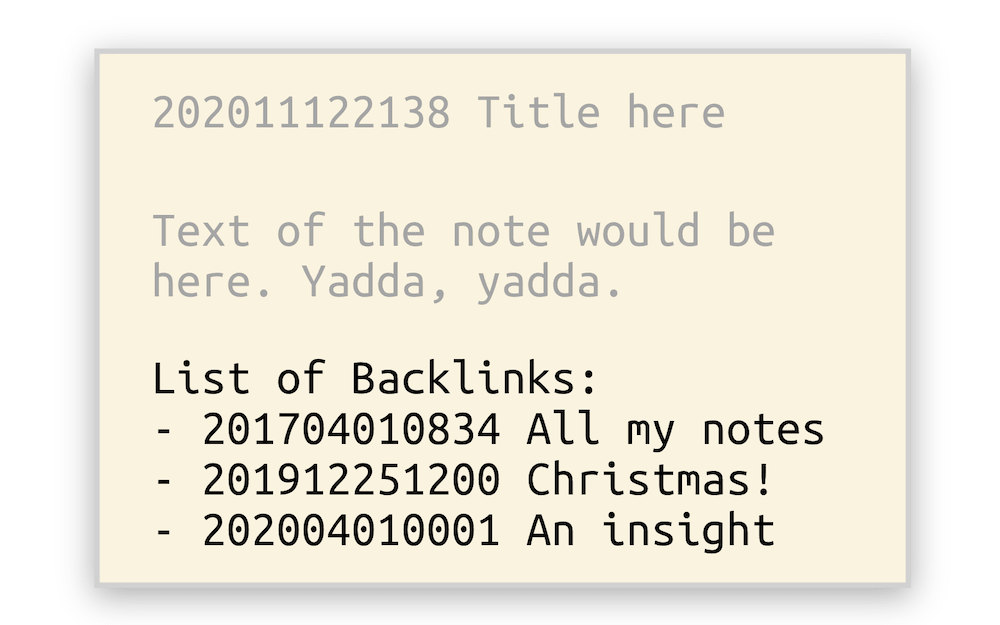Backlinking Is Not Very Useful -- Often Even Harmful
Disclaimer: I talked with Christian about what backlinks are. I don’t mean it as a technical concept like software and web developers would use the term. To me, a backlink is a link that allows you to go to files that refer to the very note you are looking at. Practically, it does not matter how the backlink is generated, by hand or presented to you by your software. Automatic backlinks are not only automatic when there is software that is showing them for you. If you create a backlink apparatus by habit it is still automatic. The automatization software would then be in your head.

To me, there is a lot of emphasis on connecting notes and very little on connecting knowledge. Connecting notes is very simple. Place a link, use the Folgezettel Technique, create a tag or something like that. But this does not connect knowledge. On the other hand, connecting conclusions and premises creates arguments which is some kind of knowledge.
This confusion is understandable because you actually need to place a link to connect the knowledge the now connected notes contain. But this is only necessary, not sufficient.
Backlinking is a perfect example on how a feature of a program seems to be useful but in reality distracts from that what you actually want to do. Backlinking is just linking notes without connecting knowledge. To understand the problem, we need to learn about link contexts.
Practically, the link context is an explanation on why you should follow a link. A good link context explains what you can expect if you follow the link. But it can also explain the nature of the relationship between both notes.

Capturing this explicit reasoning is the very thing that makes linking truly productive by creating a network of meaningful connected knowledge. Without explanation, without reason why there is connection at all, there is just mindless linking without knowledge connection.
You will spend time surfing the link structure of your Zettelkasten a lot. You will do it in the context of thinking with your Zettelkasten. Each link provides you with a choice between multiple options.
- You can follow the link and move on from the linking note.
- You can anchor the note in your memory and follow the link with the intention to come back to the linking note.
- You can ignore the link.
There is really a lot of choice going on that we are not immediately aware of.

If choice is present, its cousin named “opportunity cost” will be there, too. That means that if you follow one link, you didn’t follow another. If you have the intention to come back from the referenced note to the linking note you are more inclined to not follow a link that leads you further away from the “source note”. This might not seem like a big deal to you. However, if you reach a stage of complexity with your Zettelkasten in which it develops its true productivity, choice and accompanying opportunity cost will be a major factor.
Following a link for no good reason is not a productive habit. In fact, this is the habit that makes the internet a productivity killer. We will come back to this later.
To understand why backlinks are bad links, we need to understand what good links and bad links are.
I always say good linking means that you
- place any link manually.
- give your future self a good reason to follow the link.
This is the necessary preparation for your future self if you want to reach the stage of complexity with your Zettelkasten that unlocks its true productivity.
The contrasting bad habit is writing “see also:” and just drop the link. If you also mention the title of the note, but only if you named your note appropriately, this would provide minimal context. However, if you link to a number of notes in that manner, the references will blur. Then you have to make the choice that you should have made already when you wrote the note while you read: Why follow this link and not that one over there.

Backlinks are bad linking on crack and steroids. Not only do they not provide any link context other than the title, but they are placed automatically. That means that your system (executed by software or habit) provides you with more choice and therefore more cognitive load. On top, you will check the backlinks if provided and that creates opportunity costs. Reviewing the backlinks is time you don’t spend with other cognitions. You will spend more time with wasting time.
Just think a moment about how difficult it really is to use the internet and its web in a productive way. The single most productivity-destroying problem with using the internet is the temptations link provide. The same is true for your Zettelkasten if your link structure is not well-groomed.
Let’s return to the issue of backlinks and take a look at the bigger picture. Backlinks will provide you with one of the least useful type of link: None, or only minimal, link context and therefore no or minimal good reasons to follow them. To make it even worse: With automatic backlinks, this dilution is not even a product of your own choice but the choice of a soulless machine (or your habit, which also has no soul).
Backlinks are a perfect example on how features of software not only can be useless but actively harming you work by redirecting your attention towards to the superficial belief that you need to place links, instead of trying to connect knowledge.
Christian’s Comment: I approach most things from a technical point of view; it’s a hole I dug myself into thanks to years and years of programming. To me, the whole backlink discussion only made sense as something generated by the software: when I place a link in note A to note B, that’s a regular link, a link link, a forward link. Traversing this directed connection backwards is what makes a backlink. Actually writing into note B a reference back to note A and call this a backlink?! Madness! That’s just another forward link!!!11 – But the discussion with Sascha showed me that I focus too much on the representation of links, instead of taking them for their use value!